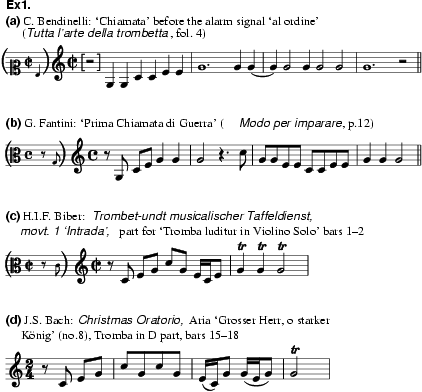
(It.: ‘call’; Fr. chamade; Sp. chamado).
A term indicating a monophonic trumpet or horn call, or a homophonous imitation of the same on other instruments, normally strings. The chiamata was apparently introduced shortly before 1600 as a prefatory piece to a newly developed series of military trumpet calls known as ‘alarm’ signals. In the course of the 17th century it came to supersede the military toccata, which had performed a similar function for an older body of military calls. The chiamata was originally a single-section piece consisting of a characteristic arpeggio figure rising from g to g', followed by a rapid reiteration of the latter pitch (ex.1a). The form was extended before 1630: the first section was occasionally given a varied repeat; and a second section, comprising an arpeggio figure falling from c'' to c' before rising to a rapidly reiterated g', was added (ex.1b). Bendinelli (Tutta l’arte della trombetta, 1614) and Fantini (Modo per imparare di sonare di tromba, 1638) included military chiamatas together with their associated military trumpet calls. Fantini also included an unassociated ‘prima chiamata di guerra’ and composed six free-standing chiamate di capriccio, which add to the two-section form the same music transposed one octave higher. During the second half of the 17th century, the trumpet chiamata reverted to a single-section form, now an arpeggio rising and falling, c'-c''-c', and terminating on g', which was sometimes reiterated and/or trilled upon (ex.1c). It was employed in many signals into the 19th century.

The term chiamata was also employed more generally to describe the ‘alarm’ signals themselves, as in Mersenne’s ‘Autre Charge ou Chamade’ (Harmonie universelle). In this sense it indicated ‘a call, or summon, … a parley … [or] challenge’, as noted by Randle Cotgrave (Dictionarie of the French and English Tongues, 1611), John Florio (Queen Anna’s New World of Words, 1611), Gervase Markham (The Souldiers Exercise, 1639), Du Praissic (The Art of Warre, trans. J. Cruso, 1639) and others. Walther (Musicalisches Lexicon) expressly associated chiamata with ‘the sound of trumpets and timpani challenging a [besieged] city’; chamade was ‘a sign given by a trumpet or drum to notify the enemy that one wished to make some suggestions to him regarding the surrender of his besieged place’. Altenburg (Versuch, 1795) described the conventions pertaining to such dispatches, including the sounding of ‘a signal consisting of several so-called calls [Rüfe]’.
The musical figure of the chiamata became associated with the circular hunting horn as it came into use during the 17th century. Orchestral chiamate – particularly the chiamata alla caccia, a short programmatic piece for strings representing the bustle of the hunt and based on rising and falling arpeggio figures – feature in some 17th-century stage works, including Cavalli’s Le nozze di Teti e di Peleo (1639) and Lully’s La princesse d’Elide (1664). The call was quoted by a number of composers, most notably Christoph Strauss (Missa ‘Veni sponsa Christi’), Biber (Sonata a 7, 1668; Trombet undt musicalischer Taffeldienst) and J.S. Bach (Suite no.1 in C; Brandenburg Concerto no.1; and in the obbligato trumpet part to the bass aria ‘Grosser Herr, o starker König’ of the Christmas Oratorio, ex.1d).See also Signal (i); and Tuck, tucket.
M. Mersenne: Harmonicorum libri, i (Paris, 1635, repr. 1648/R)
H.C. Koch: Musikalisches Lexikon (Offenbach, 1802/R)
E.H. Tarr: ‘Monteverdi, Bach und die Trompetenmusik ihrer Zeit’, GfMKB: Bonn 1970, 592–6
P. Downey: The Trumpet and its Role in Music of the Renaissance and Early Baroque (diss., Queen’s U., Belfast, 1983)
K. Hofmann: “‘Grosser Herr, o starker König”: ein Fanfarenthema bei Johann Sebastian Bach’, BJb 1995, 31–46
PETER DOWNEY, EDWARD H. TARR